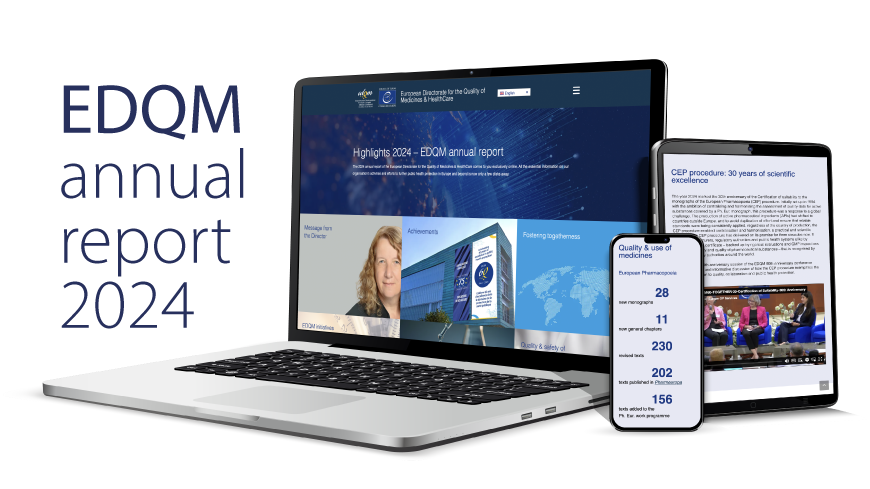N-nitrosamine contamination in brief
European Pharmacopoeia strategy
New strategy for N-nitrosamine impurities in Ph. Eur. monographs
At its 177th session in November 2023, the European Pharmacopoeia Commission (EPC) approved the strategy for N-nitrosamine impurities in individual monographs.
More information available here.
Revised general monographs 2034 and 2619 with new paragraphs on control of N-nitrosamines
At its 174th session in November 2022, the European Pharmacopoeia (Ph. Eur.) Commission adopted the revised general monographs Substances for pharmaceutical use (2034) and Pharmaceutical preparations (2619), which now include a paragraph explaining the Ph. Eur. approach to N-nitrosamine impurities.
More information available here.
Rapid implementation of the revised sartan monographs on 1 April 2021
In February 2021, the European Pharmacopoeia (Ph. Eur.) Commission published five revised monographs on sartans containing a tetrazole ring (Valsartan, Losartan potassium, Irbesartan, Candesartan cilexetil and Olmesartan medoxomil) using its rapid-revision procedure. To keep Ph. Eur. requirements in line with the latest EMA regulatory decisions,[1] the “Production” sections of the revised monographs were reworded and the N-nitrosamines test section was deleted. For more information, read the press release.
Revising relevant Ph. Eur. monographs to add limits for N-nitrosamine impurities
On 2 April 2019, the European Commission adopted a legally binding decision on nitrosamine impurities in medicines containing the five active substances initially concerned (valsartan, candesartan, irbesartan, losartan and olmesartan). In response, the Ph. Eur. Commission decided to revise the corresponding monographs (Valsartan, Losartan potassium, Irbesartan, Candesartan cilexetil and Olmesartan medoxomil).
The revised monographs, published in the 10th Edition of the Ph. Eur. in June 2019 and effective as of 1 January 2020, include the interim limits for these impurities (NDMA and NDEA) described in the Annex to the European Commission decision. These interim limits were applicable for a two-year transitional period, during which batches containing NDMA or NDEA above the interim limits, or both nitrosamines at whatever quantifiable level, were not allowed on the market.
On 13 November 2020, the EMA published a news item[1] indicating that its human medicines committee (CHMP) had aligned recommendations for limiting nitrosamine impurities in sartan medicines with recommendations it issued for other classes of medicines. The main change concerned the limits for nitrosamines: where they previously applied to active substances, from that time on they applied instead to the medicinal products. Consequently, the Ph. Eur. Commission adapted its strategy and further revised the monographs on the five active substances initially concerned (valsartan, candesartan, irbesartan, losartan and olmesartan) by suppressing the texts under the “Test” section and rewording the “Production” section. The revised monographs were published in the Ph. Eur. Supplement 10.6 (July 2021).
1. European Medicines Agency, “Nitrosamines: EMA aligns recommendations for sartans with those for other medicines”, 13 November 2020.
Elaborating a Ph. Eur. general chapter providing analytical procedures to control the relevant N-nitrosamines
At its 168th session in November 2020, the Ph. Eur. Commission adopted a new general chapter on the analysis of N-nitrosamines in active substances (2.5.42, previously listed as 2.4.36).
The general chapter should be seen as an analytical toolbox that proposes three procedures relying on more or less sophisticated instruments (GC-MS, LC-MS/MS and GC-MS/MS). It was considered important to include a varied set of procedures using different instruments, thus covering the diverse needs of many quality-control laboratories in Europe and beyond.
More information available here.
Ph. Eur. reference standards
To support the implementation of the Ph. Eur. general chapter on the analysis of N-nitrosamines in active substances (2.5.42, previously listed as 2.4.36), seven reference standards were established (namely N-nitroso-dibutylamine, N-nitroso-diethylamine, N-nitroso-diisopropylamine, N-nitroso-dimethylamine, N-nitroso-dipropylamine, N-nitroso-ethyl-isopropylamine and N-nitroso-N-methyl-4-aminobutyric acid). They are available from the EDQM.
More information available here.
CEP procedure
Since 2018, when the EDQM became aware of the presence of NDMA (a nitrosamine impurity) in a specific source of valsartan, a number of activities have been carried out in order to mitigate the risks of presence of nitrosamine impurities in active substances covered by CEPs. A summary of these activities is presented below.
All CEP dossiers for sartans containing a tetrazole ring have been updated to address the potential presence of nitrosamines in compliance with the latest decisions taken at EU level, which have been incorporated into the corresponding European Pharmacopoeia (Ph. Eur.) monographs.
In September 2019, the European Medicines Agency (EMA) initiated a procedure under Article 5(3) of Regulation (EC) No 726/2004 to provide guidance to marketing authorisation holders on how to avoid the presence of nitrosamine impurities in human medicines (see the EMA webpage on nitrosamine impurities). The EDQM issued a similar call for review (link) to CEP holders in October 2019 that triggered a wide-ranging review of the CEP applications concerned.
Where are we now with the call for review?
The review process is ongoing and steps 1 and 2 have been completed: CEP holders should have performed the risk evaluation for nitrosamines for their substance(s) and, where a risk was identified (step 1), they should have provided the results of the expected confirmatory testing to the EDQM (step 2). For applications where no risk was identified by the CEP holders, no feedback was expected from them and no dossier review was carried out unless other evidence received dictated otherwise.
For CEP dossiers identified by CEP holders as at risk for nitrosamines, the process is now in the third step of the call for review, i.e. assessment of requests for revision to amend the manufacturing process and/or introduce controls (e.g. limits in specifications), as necessary. The deadline for this step has been extended to 1 October 2023 (click on the date to have the link).
What about the dossiers already reviewed?
Irrespective of the substance, all new or renewed CEPs granted since the beginning of 2019 have included an evaluation of the formation of or contamination with nitrosamines (for more information on the content of the risk assessment, see below). This also applies to any revisions where a nitrosamine risk may be introduced or altered (e.g. change to synthetic route or sourcing of materials).
The EDQM has also reviewed most of the applications where a nitrosamine risk was identified. Where limits are mentioned on CEPs, these are based on the acceptable intake limits for nitrosamines published by the EMA in their Questions and Answers for marketing authorisation holders/applicants on the CHMP Opinion for the Article 5(3) of Regulation (EC) No 726/2004 referral on nitrosamine impurities in human medicinal products.
If no limit for nitrosamines is mentioned on a CEP, this means that either no risk was identified or, if a risk was identified, that these impurities are not present in the active substance and that appropriate controls have been introduced to ensure their absence in line with ICH M7 principles.
When should a nitrosamine risk assessment be submitted and what kind of information should it contain?
Any new application (chemical or herbal applications), sister file, renewal application or revision where the risk of nitrosamines is potentially modified or introduced should include a summary of the risk assessment for the presence of nitrosamines based on the principles outlined in the ICH Q9 and ICH M7 guidelines. The risk assessment should address not only risks from the manufacturing process, but also those from the introduction of materials used in the manufacturing process (starting materials, reagents, solvents – fresh and recovered, etc.) as well as degradation.
In the event that a risk of the presence of nitrosamines is identified as a result of the risk evaluation, confirmatory testing should be carried out using appropriately validated and sensitive methods and the test results should be included in the CEP application.
Where nitrosamine impurities are detected, CEP holders should implement appropriate measures to mitigate the risk (such as additional controls or amendments of the manufacturing process), and normally a limit should be included in the specification of the active substance.
CEP holders also have the option to include the risk assessment in their CEP dossier via a minor revision.
Find more information here on the risk assessment to be submitted in the context of the call for review.
Update on international collaboration
The EDQM co-operates continuously with regulatory authorities at national, EU and global level – e.g. via the Nitrosamines International Strategic Group (NISG) – on this issue and will continue to do so to ensure a co-ordinated, harmonised approach to making and implementing decisions.
Do GMP inspectors check for nitrosamine risks?
In recent years, the EDQM has also played an active role in programmes for the inspection of active substance manufacturers, including re-inspections of some production sites involved in the manufacture of sartan active substances, to confirm that appropriate manufacturing and GMP measures have been implemented.
During an inspection, inspectors systematically check that the company has carried out an appropriate risk evaluation for nitrosamine impurities.
Remember nitrosamines…a few dates:
July 2018: Investigation of nitrosamine impurities in valsartan
September 2018: Investigation extended to sartans with a tetrazole ring
February 2019: CHMP Article 31 referral report published: companies to review manufacturing processes to avoid presence of nitrosamine impurities in sartans with a tetrazole ring for human medicinal products
September 2019: EMA review initiated under EU Article 5(3) of Regulation (EC) No 726/2004 for human medicinal products containing active substances manufactured by chemical synthesis
October 2019: EDQM call for review (stepwise investigation process by CEP holders regarding presence of nitrosamines in their API). More info on EDQM call for review (https://www.edqm.eu/en/w/nitrosamines-risk-assessment-update-for-cep-holders-1) and (https://www.edqm.eu/en/w/nitrosamines-update-from-the-cep-procedure)
March 2020: extension of the deadline for step 1 (risk identification) of the EDQM call for review to 31 July 2020
July 2020: scope extended (by EMA & EDQM) to all chemical and biological medicines
July 2022: extension of the deadline for step 3 (submission of a revised application following risk assessment) of the call for review to 1 October 2023
September 2022: deadline for step 2 (when a risk of nitrosamines has been identified, submission of confirmatory test results)
October 2023: deadline for submission of a revised CEP application when a risk has been identified
Work on sampling strategies and testing methods with OMCLs
Co-ordinated sampling and testing
Co-ordinated sampling and testing ensures that analytical test procedures for the determination of nitrosamines are developed and made available to stakeholders. The EDQM took part in efforts to co-ordinate the development of testing procedures that ensure adequate control of impurities, as well as a risk-based sampling and testing programme focusing on the most pressing issues. These allowed all members of the European Network of OMCLs with the necessary equipment at their disposal to ensure efficient and targeted controls of medicinal products containing sartans. This was a crucial step in providing strong and efficient technical support to regulatory authorities.
In spite of the challenges related to testing nitrosamines, notably the need to develop highly sensitive detection methods, the broad coverage of N-nitrosamines and the need to test different types of APIs, the OMCL Network developed analytical methods for the determination of NDMA following three general principles, as well as specific methods for determining NDEA. An additional method released by a German OMCL (CVUA Karlsruhe) was the first to simultaneously determine the presence of both NDMA and NDEA in sartan tablets. A specific method for NMBA (N-nitroso-N-methyl-4-aminobutyric acid derived from the use of N-methylpyrrolidone) was also developed by the Bavarian OMCL and published on the EDQM website. Over time, the published methods have been further refined to make them suitable for a broader spectrum of molecules and/or to cover additional nitrosamines and other genotoxic substances (e.g. of the Azidomethyl-type). An overview of publicly available methods developed by the OMCL Network and by partner organisations can be found on the EDQM website, under Ad-hoc projects of the OMCL Network.
The OMCL Network, co-ordinated by the EDQM, has developed:
- a common format for communicating sampling plans and testing results among participating laboratories;
- a risk-oriented sampling plan in discussion with the EMA, national competent authorities (NCAs), inspectorates and CMDh representatives which is continually updated.
The purpose of testing activities has been to measure levels of contamination in the products concerned, to perform market surveillance of similar products and of products theoretically of low concern, and to analyse samples derived from GMP inspections.
The analytical methods of the OMCL Network/EDQM are also used:
- to test APIs other than sartans, coming from “suspected” production sites;
- as a starting point for developing methods for future Ph. Eur. work on general methods.
Furthermore, test methods for additional N-nitrosamines, such as NDIPA (N-nitroso-diisopropylamine), NEIPA (N-nitroso-ethyl-isopropylamine), NDBA (N-nitrosodibutylamine), NMBA (N-nitroso-N-methyl-4-aminobutyric acid derived from the use of N-methylpyrrolidone) have been developed by the OMCLs.
This work continues with new types of N-nitrosamine contaminants being reported in the course of the “call for review” procedure (above).
2024 EDQM annual report showcases our unwavering dedication to improving public health
Making a significant difference – 2023 EDQM annual report published in new engaging digital format
Click here to subscribe.






